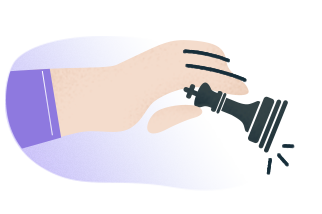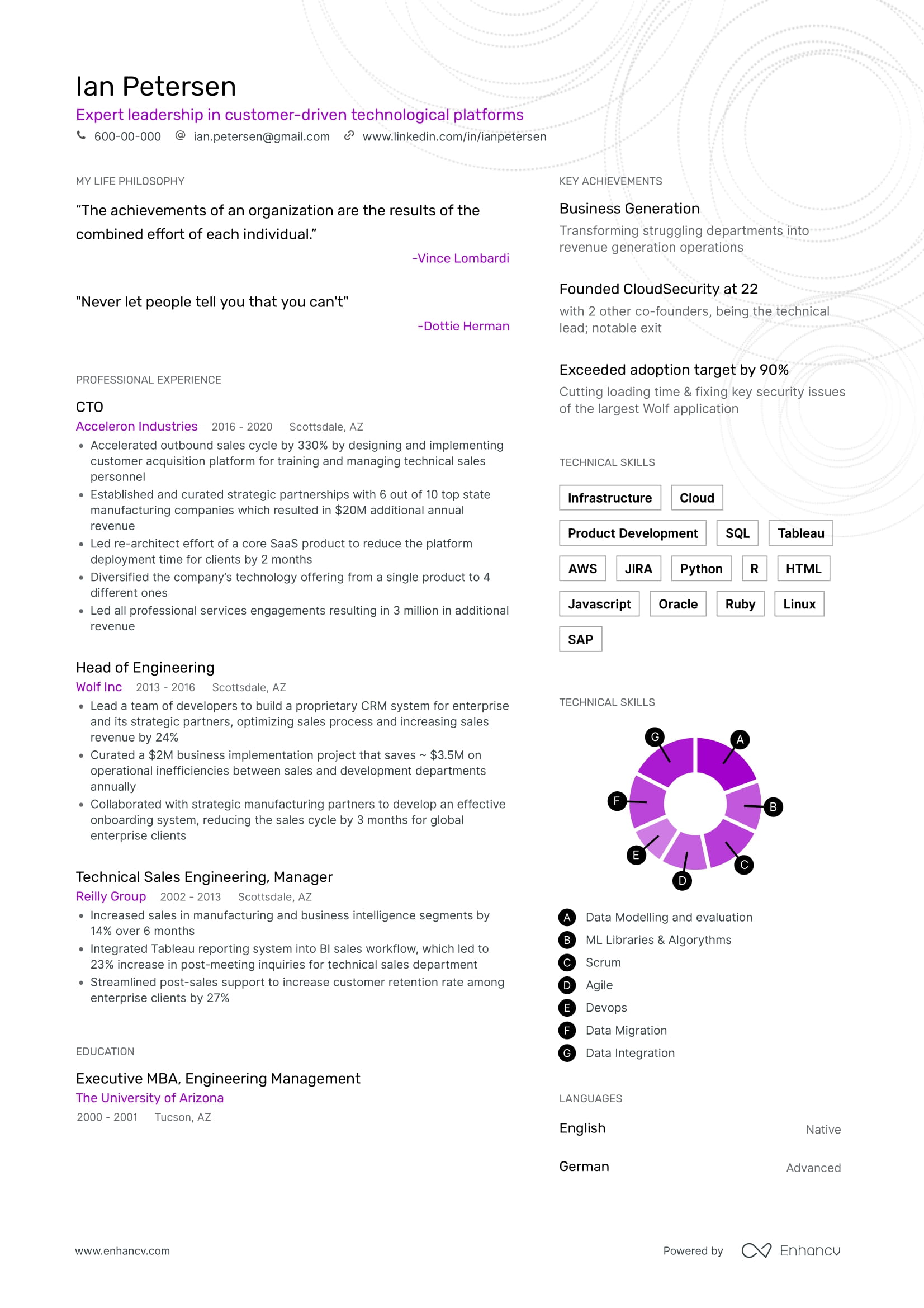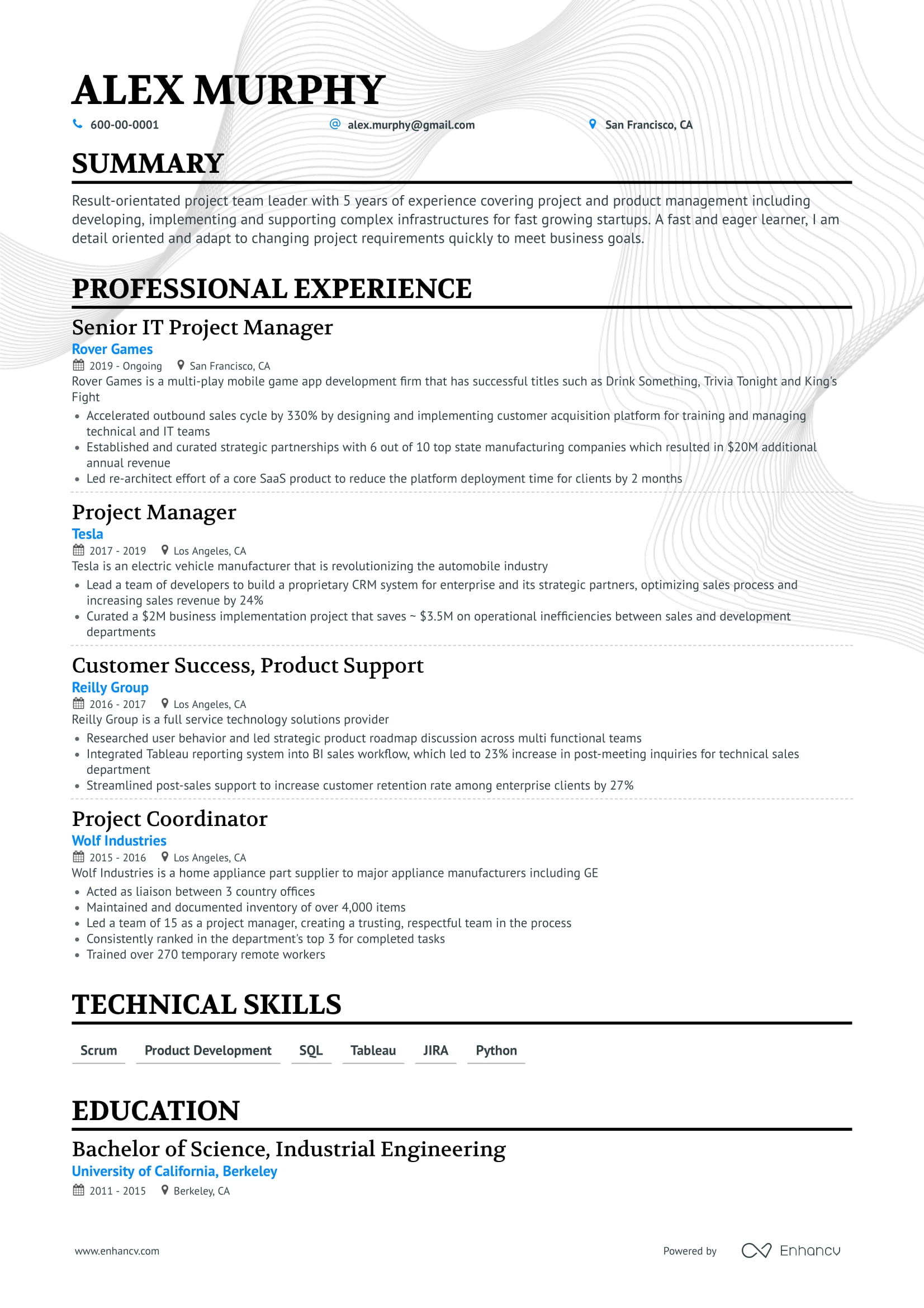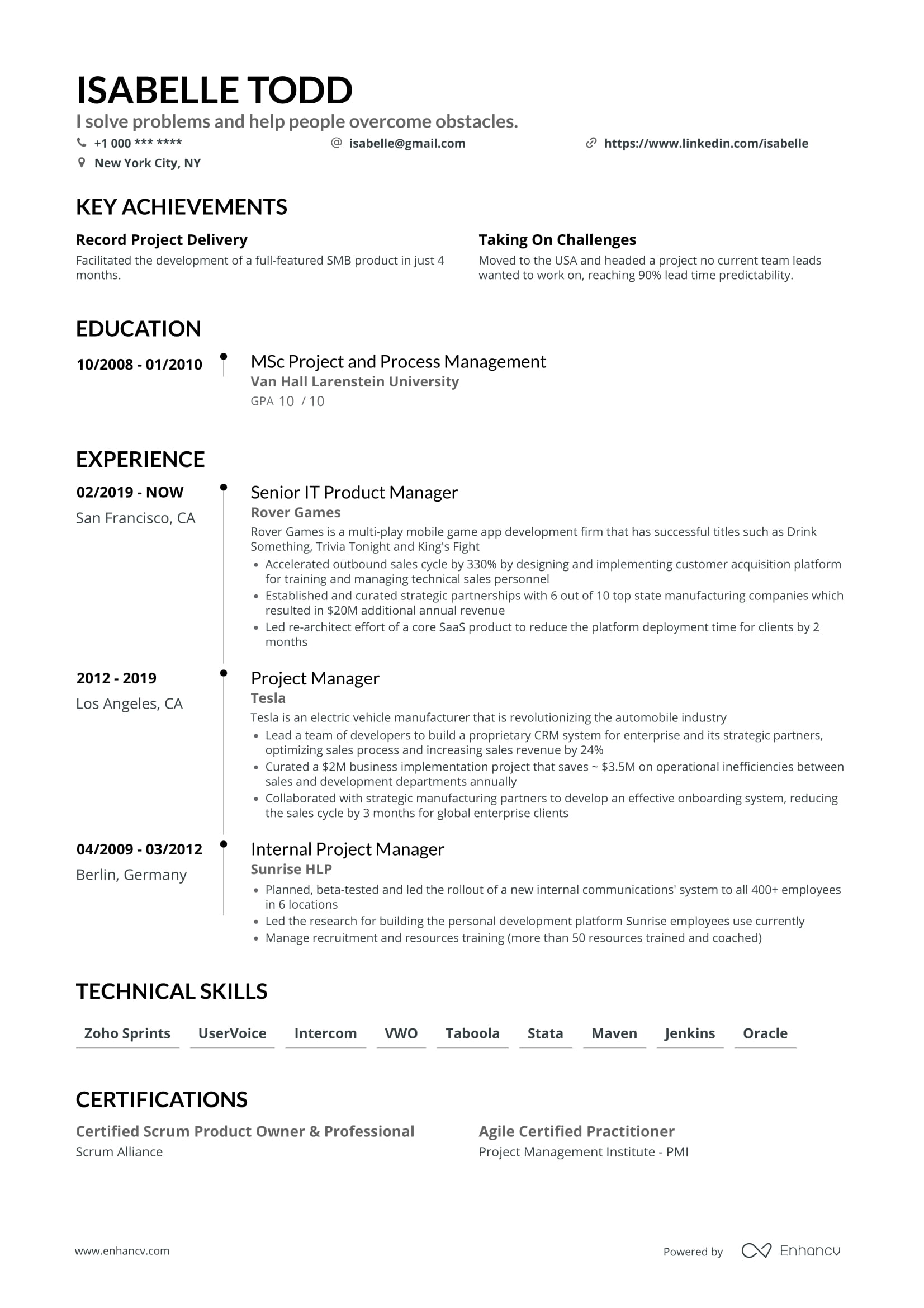Example Tableau Developer Resume - Browse more resume templates and build a stand-out resume
Every business wants a piece of that data intelligence pie, and that’s exactly why Tableau professionals are in such high demand.
There is, however, one problem. Everyone and their dog thinks they know a thing or two about data.
Because people love beautiful charts, graphs, numbers — it makes us all feel like data analysts in a way.
That’s why so many people think they can do the job. Of course you, as a Tableau developer, know better.
You know how much work goes into creating truly insightful dashboards, managing multiple data sources, administering Tableau users, and so much more.
But if your resume doesn’t show how professional you are, it’ll get lost in the pile of generic resumes from hobbyists and data enthusiasts.
Are you ready to get your next great job in business intelligence with your Tableau resume? Read on.
What this Tableau resume will teach you
- Explore 8 Tableau resume examples and analyze what makes them good or bad;
- How to leave an impression with recruiters that you’re the Tableau professional they need;
- How to write an attention grabbing Summary that is tailored specifically to the job you’re applying for;
- How and where to properly list technical and soft skills on your resume so that recruiters won’t toss your resume out when they see it;
- What are the most important sections in your Tableau resume and how you should write them.
Tableau resume sample
Check other related resumes from the industry
- SQL Data Analyst resume
- SQL Developer resume
- Database Analyst resume
- Data Scientist resume
- Data Engineer resume
How to write a Tableau resume that gets you interviews
The problem with most Tableau resumes is that they are awfully generic.
You might have very advanced experience in configuring and using Tableau solutions, but if your resume looks like you’re just drawing pie-charts on command, you won’t get too far.
Anyone can draw pie-charts, especially in a business environment. That’s the baseline.
Just like a well-presented data visualization tells a story of business, your Tableau resume should tell a story of how good and versatile of a Tableau professional you are.
Recruiters, just like any other people, love good stories
And every section of your resume should be a part of this story.
Which are the top sections of a proper Tableau resume
- Properly formatted Header section with relevant and convincing profile links
- Concise, attention-grabbing Summary tailored to the job you want
- Neatly framed Experience section to make your resume top priority with recruiters
- Technical Skills section with the most relevant and demanded skills for the job
- List of certifications to strengthen your resume
By skillfully combining different aspects of experience with Tableau, business analytics, and data management, you make recruiters understand that you’re that one candidate they need.
Here’s what recruiters want to see in Tableau developer resumes
- Portfolio that features your excellent skills in visual reporting
- Business-driven approach to creating and analyzing visual data
- List of relevant technical and soft skills needed for the job
- Education and certification sections or equivalent working experience
- Engaging and efficient work history
The best layout to demonstrate your Tableau experience is the standardreverse chronological format.
For more information on the best resume formats, read our guide:The Best Resume Formats You Need to Consider (5+ Examples Included).
Now, time to go over and dissect every section of that resume.
Tableau Developer resume header that gets noticed
The way you format your header depends on the position you’re applying for.
Although there are some debates online as to whether Tableau developers are “developers” and not “specialists” or “consultants”, the majority of Tableau positions and recruiters seek Tableau developers.
So, in most cases, use “Tableau Developer” in your resume header. The only exception would be the jobs that list Tableau as “extra skills”, e.g. Business Analyst or Data Analyst.
Header is often a great place to feature a link to your portfolio, personal website or LinkedIn.
If you don’t link to your profile, you’re missing out on a lot of traction with recruiters.
See? No link is bad. But the header for Tableau developers is a hidden treasure in its own way.
It’s here where you can link to your public Tableau profile filled with dashboards and graphs that you generated using the Tableau Public platform.
This is a great opportunity not only to showcase your experience with Tableau tools, but also to charm recruiters with beautiful visualisations.
It also boosts your credibility to associate yourself with Tableau that way. It’s similar to how Tableau certificates boost your credibility in the Certificate section.
Just remember this: Tableau Public is a public platform and everyone will have access to your graphs.
Never include dashboards with sensitive data that you’re not legally allowed to share, e.g. operational data from your past clients and their businesses.
If you want more ideas for stand-out resume headers, read through our guidePerfecting Your Resume Header so You Get Noticed.
Now that your header is set up, let’s move to the Summary section of your Tableau resume.
Tableau resume summary: how to get the best out if it
The biggest mistake you can make with your Summary is to simply list all the Tableau skills and workflows that you’re familiar with.
First off, you won’t have enough space, and there are Experience and Skills sections for that.
Second, if there’s a mismatch between skills that you’ve included in your Summary and target job’s description, recruiters may reject your resume without reading the following sections.
What if they work with SQL Server and not OracleSQL?
Finally, you rob yourself of a great opportunity to increase your Tableau resume appeal and tailor your resume to the exact position you’re applying for.
The thing is, no two Tableau Developer positions are the same.
At one place, your employers may prioritize your ability to create exceptional and business-driven visual dashboards with little to no supervision.
Other companies may value your Tableau administering skills: how you set up and manage user access, install and migrate Tableau software on different platforms and so on.
Although most Tableau Developer roles require all of the above, prioritizing something your employer emphasizes won’t do any harm.
It’s also a good idea to highlight if you have experience in the same domain as the job you’re applying for, e.g. finance, health, etc.
For more tips on crafting an attention-grabbing resume summary, check out our guideResume Summary: How-To Guide (30+ Examples You Need To See).
If you’re looking to craft a compelling resume objective instead, read our writing tips at10 Resume Objective Examples You Need to Steal (How-to-Guide).
With your eye-grabbing Summary tuned up, we’re ready to proceed to the heart of your Tableau resume — the Experience section.
Tableau resume experience: how to position yourself
Your experience section is the gist of your resume, because it allows you to demonstrate how proficient you are with Tableau in the context of real workflows and achievements.
It’s the section that makes you stand out from the majority of people who can create a bar chart and export an Excel sheet.
And it’s the section where you should justify why a company should spend $100,000 every year to keep you on the payroll and not someone else.
There are three main categories that your experience section should cover:
- Tableau Utility Experience
- Data Management Experience
- Tableau Administering Experience
Tableau Utility Experience includes your ability to build visual reports utilizing the Tableau platform.
But that’s not just about building fancy graphics.
You’re not a VFX artist, so your goal is to present data in a way that isn’t necessarily entertaining, but educating, insightful, and business-oriented.
The best way to do that is to demonstrate how useful your dashboards were to the particular business you created them for. You can either use numbers or storytelling techniques for that.
Bad example: created a series of dashboards for business keyholders
Good example: created a series of dashboards that enabled BI department to analyse and improve advertisement attribution, increasing the annual ROI of advertising marketing by 26%.Feel free to include those keywords on your resume, especially if you see them featured in the job description. We’ll talk in detail about tailoring your skills to the job in the Skills section.
Potential keywords: business intelligence, ROI, visual report, dashboard, presented, parameters, calculations, forecasting, data analysis.
Data Management Experience includes any technical skills that allow you to manage sources for your visual reports.
Those typically include writing SQL-queries, managing data warehouses, and analyzing new and existing data sources.
Potential keywords: Data warehousing (DWH), SQL, Data marts, ETL.
Tableau Administering Experience includes managing user roles and permissions on the Tableau Server platform, managing report distribution, installation, licensing, and user training.
Potential keywords: training, migrating, management, installation, configuration.
If the position that you’re applying for emphasizes one aspect of a Tableau Developer role over the others, feel free to expand on that particular experience in your resume.
For example, if a position mentions no SQL-queries, but focuses more on data analysis, data discovery, and visual report building, feel free to write more about it in your experience section.
Below are two resume examples for your Tableau Developer resume.
This resume example is generic and doesn’t project any business value that you as a Tableau Developer bring to the table.
This second one is more business-driven, with specific and engaging examples for all three areas of Tableau Developer work.
For more ideas on how to create an actionable resume experience section, check out our guideHow to Describe Your Resume Work Experience.
With your Experience section up and running, let’s amaze recruiters with the diverse pack of your skills in the Skills section.
Tableau resume skills section: importance and tips
Tableau Developers are often jack-of-all-trades in all things related to data visualization in their companies.
Their technical skillset can cover anything from SQL-queries to Python scripting and Cloud platforms management.
Of course, the exact skill set varies from job to job, so it’s always a good idea to carefully examine the requirements of each particular job and frame your Skills section appropriately.
Here’s an example from Tableau Developer job description:
- Experience training and providing expert consulting on Tableau techniques and best practices
- Strong oral and written communication skills, with the ability to effectively communicate with both technical and non-technical audiences at all levels within technical and business organizations.
- Expertise in designing effective visualizations of analytics
- Proficiency in SQL and relational database modeling fundamentals
- Strong knowledge of data-related end-user desktop applications (e.g. Excel, MS Access)
- Familiarity with banking, financial concepts, financial data and market data
- Web Development Experience (e.g. HTML, CSS, Javascript) is a plus
- Experience with ETL Self-Service Applications (e.g. Alteryx) is a plus
If you have skills that are highlighted, put them first in your skill section, and then add everything that's left.
Listing your technical skills
Below are the most common technical skills you should put on your Tableau resume:
Top 16 technical skills for Tableau resume
- Tableau Desktop, Server, Online, Reader, version 8.x 9.x,10.x
- SQL (MS SQL, Oracle, MySQL, etc.)
- ETL frameworks
- Data Warehousing
- Salelsforce
- AWS
- BigData Analysis
- Excel, MS Access
- Business Intelligence Software (SAP BA, Looker, etc.)
- Java
- RedShift
- Hadoop
- Cloud data platforms.
- Tableau REST API
- Python
- Domain-specific software (e.g. banking software, engineering software)
- OLAP
Listing soft skills on your resume
No less important are the soft skills on your Tableau resume.
Dashboards and reports are used to communicate a certain idea or create a context, but there’s always a person standing behind the data to clarify and elaborate, and often that’s you.
Also, it’s often required of Tableau Developers to explain how Tableau reporting works to other corporate users and management.
That’s why skills like communication and presentation should always be there on your Tableau resume.
Of course, complemented by your core analytics, creativity, and problem solving skills.
Top 12 Tableau soft skills on your resume
- Excellent Analytical Skills
- Communication
- Presentation
- Storytelling
- Forecasting
- Teamwork
- Visualisation
- Creativity
- Problem Solving
- Time Management
- Training
- Documentation
Are you still not sure what skills will win recruiters over? Check out our guide onHow to Create A Resume Skills Section To Impress Recruiters (+10 Examples You Need to See).
Tableau resume education section: how to make it stand out
Although a Bachelor's degree in Computer Science or a related field would be a nice addition to your Tableau resume, it’s not necessary.
Apart from a CS degree, a degree from a relevant domain would work just fine in business reporting.
For example, a degree in economics would work if you apply for a position in a financial company.
For many Tableau Developer jobs, a bachelor degree is a requirement, yet it’s not specified what specific degree they are after.
Some companies will readily hire you with no degree if you can back it up with sufficient relevant experience working in a Tableau environment.
Browse more essential tips on how to feature education on your resume, in our guidePerfecting the Education Section on Your Resume.
Should I add certificates to my resume?
Tableau Certifications are surprisingly effective in your job application process, and often you’ll find them as a desired option in many job descriptions.
SQL certifications can also be useful, specifically if you’re certified for the same technology that your target company uses.
Those are some certifications you can put on your Tableau resume:
Top 7 Tableau certificates for your resume
For more information on how to properly list resume certifications, we recommend reading our guideHow To List Certifications On A Resume (Examples Included).
Other sections to include on your resume
Depending on the company, job seniority level and your location, you may want to include more sections to your Tableau resume:
Tableau Developer resume: key tricks and insights
- Make sure your resume presents you as a Tableau professional rather than an amateur by providing relevant technical skills paired with advanced Tableau reporting workflows
- Tailor your Summary, Experience, and Skills sections to the position you’re applying for in order to convince companies you’re the only candidate they need
- Write your Experience and Summary sections to feature you as a business-driven analyst rather than a creator of fancy, but useless graphs
- Back up your technical skills with necessary soft skills, while putting them into a real world context and not just listing them as lifeless words
- Significantly increase your resume conversions by putting a link to your visual reporting projects in the Header section





